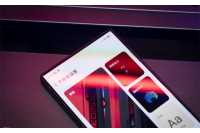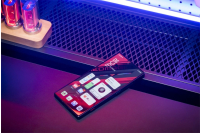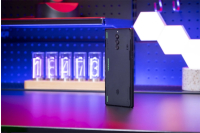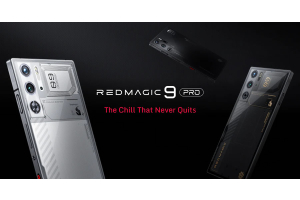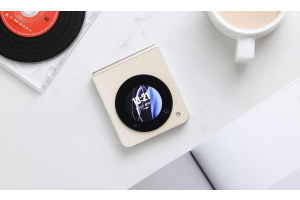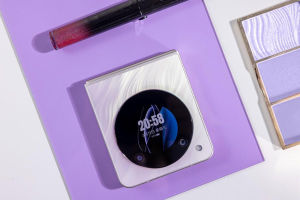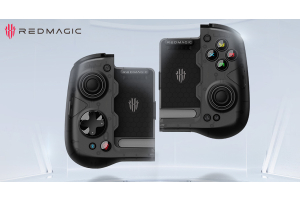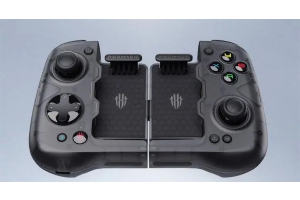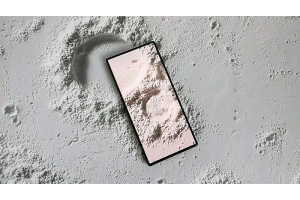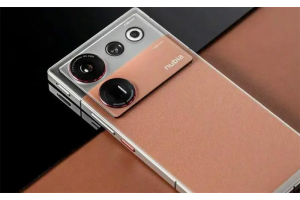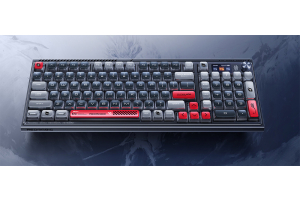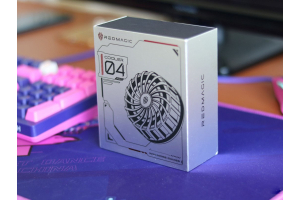RedMagic 8 Pro Review: Excellent for Gaming and Decent for Daily Use
If you need a high-performance flagship, I recommend that you take a look at the Red Magic 8 Pro. If you need a straight-screen flagship, I also recommend that you take a look at the Red Magic 8 Pro. This is because the Red Magic 8 Pro can deliver stronger performance than smartphones with similar configurations, and it has an ultimate true full-screen display.
The most significant change in the Red Magic 8 Pro is its extremely square and rugged body design. When you flip the phone over to the front, you can directly feel the impact of this change. Firstly, the Red Magic 8 Pro cooperates with BOE to incorporate a 6.8-inch AMOLED under-screen flexible straight screen, which is the first under-screen flexible straight screen. The hidden effect of the under-screen camera is further improved compared to the previous generation. Red Magic and BOE use an independent pixel driving scheme, which can effectively improve the light transmittance of the display area by controlling the display effect of each pixel point separately. They also use a transparent circuit to avoid the front camera area and install the UDC PRO+ display chip to improve the color effect and delicacy of the front area by algorithm.
As shown in the picture, no matter what color the screen displays, you can barely perceive the existence of the front camera, and the display effect in the front camera area is no different from that of the normal screen area. There is no more jaggedness in the text edge and picture line area as in the previous scheme. Now, you can only vaguely see the circular front camera when you aim the phone at strong light and observe it carefully.
In addition, the screen itself has excellent quality. This screen has a resolution of 2480 x 1116, a 120Hz refresh rate, a maximum of 960Hz touch sampling rate, a peak brightness of 1300nit, a color accuracy of △E<1, a 10-bit color depth, DCI-P3 100% wide color gamut, and supports 1440Hz PWM dimming and DC dimming. In terms of eye protection, Red Magic has always been more attentive than other smartphones. Even at extremely low brightness, the screen does not show significant color deviation and can display normally.
Secondly, Red Magic 8 Pro uses COP packaging, with only 1.48mm left and right borders, 1.68mm upper border, and the thickest lower border is only 2.28mm. However, in the human eye, it is a screen with four equally narrow edges, combined with extremely square body lines, which enhances this visual experience. The body lines of Red Magic 8 Pro are rugged, with right-angle borders. If it were not for the slight curvature at the R-angle, the entire phone would almost become a standard rectangular box. There is also a small detail: this phone can be simply placed upright on a tabletop.
Note that the extremely square body does not have any negative impact on the handling. The phone removes the screen bracket and the edges of the screen are slightly curved to seamlessly connect with the frosted metal frame. The back cover and the middle frame are also joined in the same way, and the overall feel of the phone is still within an acceptable range.
In fact, what really affects the handling is the width of the phone. In order to ensure that the game screen is displayed in the correct proportions, the Red Magic 8 Pro is slightly wider than other phones. Although from the perspective of playing games and watching videos, this is a suitable size, today's phones are generally more slender, making the Red Magic 8 Pro look a bit out of place. When you first switch to the Red Magic 8 Pro, you may feel that the phone is a bit cumbersome, but once you get used to it, it's not uncomfortable.
The excellent screen performance lays a good foundation for the impressive visual experience of the Red Magic 8 Pro. In the future, for Chinese-made phones that focus on performance and gaming, the Red Magic 8 Pro is definitely worth considering. As seen in the preheating of Red Magic, the slogan of the Red Magic 8 Pro series has changed to "Comprehensive Evolution, More Than Just Esports". They still pursue the ultimate gaming experience, but also try to balance gaming and daily use, as reflected in the design of the phone.
For the previous generation Red Magic 7/7S Pro, the appearance is a matter of personal preference. I think the design is very bold, with a strong and rigid body shape, a metal plate placed outside the body of the phone, a full-height transparent glass body, and a metal right-angle frame, creating a strong mechanical and powerful feel for the phone. However, this kind of bold body design is not acceptable to everyone. Regardless of personal aesthetics, it is difficult to associate the Red Magic 7 Pro with the concept of a "daily use phone" based on its appearance alone. With the Red Magic 8 Pro, Red Magic has changed its design philosophy and made some concessions to the mainstream audience.
The color of the phone in my hand is called "Dark Knight". The appearance has been drastically modified by removing the external metal plate and making the text and graphics on the back of the body more restrained. It's worth noting that the gaming phone's proprietary lighting effects are still present, but they are now incorporated into the logo and graphics on the left side of the phone. Additionally, the design on the back of the phone appears chaotic at first glance, but it's actually a symmetrical design with the triple camera module and bottom logo in pairs. The three cameras are slightly raised and have a metal ring around them to protect them when the phone is placed on a flat surface.
The back of the phone uses a large area of matte sandblasting technology to create a delicate texture, while the text, patterns, and graphics on the back have a shiny surface, creating two different textures on one plane. The final effect of the phone's appearance is closer to mainstream phones while still maintaining the distinctive features of a gaming phone. The red gaming key is retained on the frame, and the power and volume keys are placed in the middle of the left and right frames for easy operation. The phone's input and output ports and exhaust vents are also designed to be more compact. In addition to the Dark Knight color, the Red Magic 8 Pro also comes in a transparent version with a gold-colored logo and text on the back, and the RGB light fan is retained, making it look even more like a gaming phone. At present, there are only two colors available, and it's expected that new color options or special editions will be released in the future.
Overall, the appearance of the Red Magic 8 Pro is more restrained compared to its predecessor, especially the black Dark Knight color, which looks similar to a "conventional phone". It won't look out of place at social events, and it won't be awkward to take out and use during casual conversations. In this aspect, the Red Magic 8 Pro is clearly more acceptable compared to similar products. The second generation Snapdragon 8 has made significant progress in performance and power consumption, and even mainstream flagship phones that don't prioritize performance can provide a good gaming experience. The advantages of gaming phones have been greatly reduced, and the concept of "gaming phones" itself has been challenged.
In terms of configuration, the Red Magic 8 Pro is equipped with the second-generation Snapdragon 8, and all models come standard with LPDDR5X and UFS 4.0 flash memory, even the base version that is selected has this configuration. The machine's benchmark score is over 1.29 million, which is among the higher end of the second-generation Snapdragon 8. It is worth noting that most other second-generation Snapdragon 8 phones can score over 1.3 million, and the Red Magic's disadvantage is in the UX benchmark score, which is 185,258 points. This score evaluates the smartphone's daily use fluency, and most other products with the same chip score 190,000 or higher. If the Red Magic 8 Pro further improves its smoothness in the retail version update, then reaching the 1.3 million level shouldn't be a problem. The machine's single-core benchmark score is 1,393 points, and the multi-core benchmark score is 5,173 points, which is a huge improvement over the Red Magic 7 Pro with the Snapdragon 8 (single-core 1,257, multi-core 3,742). The GPU part has a more significant improvement, and as a result, the Red Magic 8 Pro has more powerful graphics performance, with even higher limit performance than the A16 Bionic chip, and there is even more aggressive performance tuning.
The Red Magic 8 Pro's 3DMark Wildlife benchmark score is as high as 13,617 points. For comparison, the iPhone 14 Pro scores 12,388 points on this test, marking the first time that an Android device's GPU performance has surpassed Apple's. A stronger GPU not only brings faster graphics rendering speed and higher quality to the phone, but also translates into better image quality in games. Additionally, the Red Magic 8 Pro's performance tuning is as aggressive as ever, and it is released more stably. In the 3DMark stress test, the Red Magic 8 Pro's best loop score is 14,085 points, with a small gap from the lowest score of 14,066 points, and its stability reaches 99.9%, meaning that the machine not only has strong performance, but also has stable and aggressive continuous performance release without downclocking, resulting in long-term high-frame and high-quality gaming experience. The iPhone 14 Pro's score for this part is 12,411 points, and its stability is only 64.9%. In the flash memory speed test, the Red Magic 8 Pro's sequential read and write speeds are 3,464.93 MB/s and 2,672 MB/s, respectively, and its other read and write abilities are also at a high level. The Red Magic 8 Pro performs very well in terms of basic performance, bringing out the performance level that the second-generation Snapdragon 8 should have. So, how does it perform in specific games?
Red Magic 8 Pro's gaming performance was tested using "Genshin Impact" as an example. The graphics settings were set to very high, the 60 fps mode was enabled, and the performance mode "Awakened Mode" was used, with the GPU option set to "High Quality." The test included various game processes such as running, battles, and NPC interactions, to better match players' habits. The game was played continuously for 30 minutes while connected to WiFi.
The average frame rate of Red Magic 8 Pro was 60.1 frames per second, even in combat scenes with minor frame drops, it maintained 60 fps. Minor fluctuations were observed when loading textures in locations with a lot of texture mapping, such as in the city of Liyue. Other game scenes maintained 60 fps, with no loss of image quality or brightness, and the gaming performance was very impressive.
It's worth noting that, perhaps due to the second-generation Snapdragon 8's 1+2+2+4 architecture, Red Magic 8 Pro modified the operating mode of eight cores. Currently, two A715 and two A710 cores are used as performance cores, while the X3 ultra-large core serves as performance support. This is a mainstream tuning method that differs from the previous tuning method that relied heavily on the ultra-large core. The change in architecture may have caused some issues, so it remains to be seen if Red Magic will attempt other operating modes in the future.
By the way, when playing games, it is recommended to turn on the color enhancement option developed in collaboration with Qualcomm for Red Magic. After enabling it, the color saturation and contrast of the screen will change, providing a better gaming experience. Even compared to other smartphones with the second-generation Snapdragon 8, there is little difference in average frame rate, with one device at 59 fps and the other at 60 fps. However, when examining the frame rate curve, Red Magic's advantage in smoothness is evident. These results were obtained after 30 minutes of continuous operation, and based on Red Magic 8 Pro's performance, it can maintain an average frame rate of 60 fps for at least an hour. The power consumption of Red Magic 8 Pro is also well-controlled. Under the high-quality graphics settings, the average power consumption of 60.1 fps is slightly higher, but the average power consumption is only 6.4W, which is lower than the 7W power consumption of Red Magic 7S Pro under the same settings. This shows how much the second-generation Snapdragon 8's power consumption is under control.
In terms of specifications, the Red Magic 8 Pro uses a 1115K+1216 large-size ultra-linear dual speaker, X-axis linear motor, and is equipped with Red Magic's self-developed R2 chip for controlling vibration, touch, and sound effects. The performance outside of gaming is also more comprehensive. External displays or laptops can also project game screens onto larger screens, and even use keyboard and mouse control, regardless of game type. As for the Red Magic 8 Pro, the performance of the second-generation Snapdragon 8 is very impressive, not only with strong basic performance, but also achieving better game experience under heavy loads than in the past. With low power consumption and its own heat dissipation, the body temperature is also remarkably low. At least in terms of performance and gaming, the Red Magic 8 Pro has differentiated itself as a gaming phone in terms of experience. Of course, the temperature control of this device is also amazing.
The Red Magic 8 Pro is equipped with the industry's first 3D ice-level dual-pump VC, with a volume of 2068mm³. Note that this is unit volume, not the area that other manufacturers have been promoting. This volume is at the top level for smartphones, and a larger volume represents a larger heat storage space. The VC heat dissipation plate itself is also not small in size, naturally resulting in higher heat dissipation efficiency. The phone also has a layer of graphene and has switched to a large area of penetrating wind channels to further improve the phone's heat dissipation efficiency.
Then, the remarkable body temperature appears. After 30 minutes of continuous play of "Genshin Impact," the highest temperature on the back of the Red Magic 8 Pro is only 34.2℃. Other phones with the second-generation Snapdragon 8 have temperatures around 45℃, which is 11℃ lower. Even considering the cold temperatures of winter, this body temperature is still quite impressive. The highest temperature of the frame in the body is 33.9℃, and the temperature of the front screen is slightly higher at 39.4℃. Therefore, the passive heat dissipation and fan of the Red Magic 8 Pro are indeed working.
The Red Magic 8 Pro has a built-in 6000mAh large battery, paired with an 80W fast charge, while the Pro+ version has a 5000mAh battery, paired with a 165W fast charge, both equipped with USB 3.2 interfaces. Endurance testing includes "Genshin Impact", "Arena of Valor", 1080P video playback, short video playback, browsing Weibo, and watching high-definition live streams, each lasting 30 minutes. In the end, the Red Magic 8 Pro still had 55% battery life left, which is quite impressive for a 6000mAh battery. The endurance of the Red Magic 8 Pro was also tested using software, including web browsing, 3D game rendering, and video playback, which consumed the battery from 100% to 20%, with a total test time of 7 hours and 57 minutes. Regardless of how aggressive the performance tuning of the Red Magic 8 Pro is, it is limited to performance testing and gaming. Apart from that, its power consumption is no different from other second-generation Snapdragon 8 phones. Coupled with the 6000mAh large battery, the Red Magic 8 Pro can easily last for more than a day.
Perhaps due to the overemphasis on gaming phones in the past, it is sometimes difficult for consumers to choose gaming phones over other phones, not to mention their overly hardcore appearance. The Red Magic 8 Pro reflects that Red Magic now wants to further integrate into the mainstream consumer group. This generation has a more low-key appearance, an ultra-long battery life, an ultimate under-screen straight screen, a 3.5mm headphone jack, and even enhanced imaging, gradually moving towards everyday use. If you prefer a straight screen, it's really worth paying attention to the Red Magic 8 Pro series, as a complete straight screen is really captivating. On the other hand, this phone retains the characteristics that a gaming phone should have, namely super-stable performance release and luxurious heat dissipation specifications. At least in the current second-generation Snapdragon 8, the actual gaming experience of the Red Magic 8 Pro is leading. The combination of the two aspects makes the Red Magic 8 Pro a great phone for gaming and everyday use. This is probably what Red Magic meant by "comprehensive evolution, not just esports."
